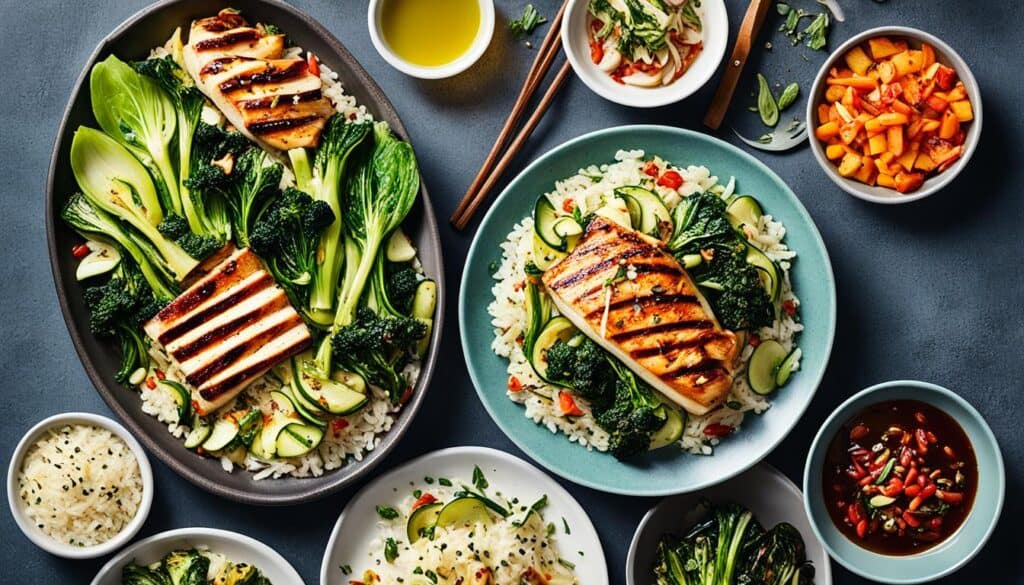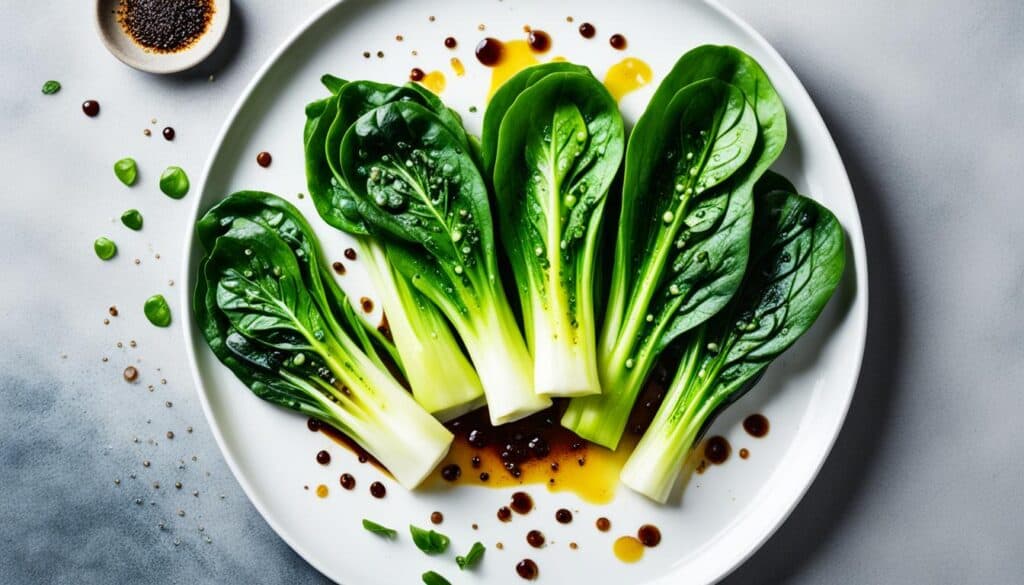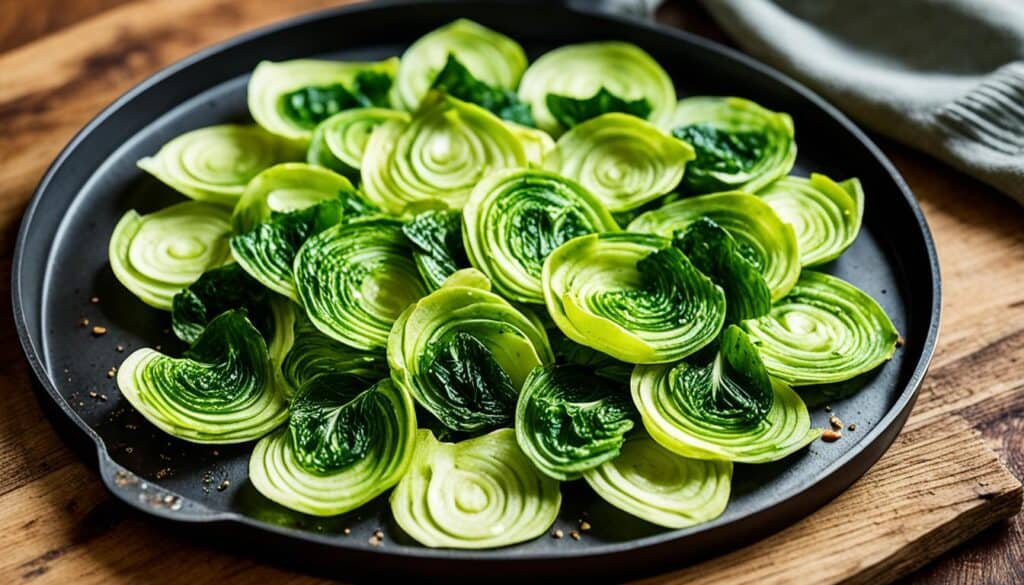Welcome to my article on how to make a delicious roasted bok choy recipe, the perfect healthy side dish for any meal. Whether you’re a fan of roasted vegetables or looking for an easy vegetable recipe to try, this Asian-inspired dish is sure to impress your taste buds. Roasting bok choy brings out its natural sweetness and creates a slight crispiness in the leaves, making it a fantastic addition to fish, chicken, or tofu.
- Roasting bok choy can transform it into a perfectly crispy and flavorful dish.
- This roasted bok choy recipe is an easy and nutritious side dish.
- Bok choy is a versatile leafy vegetable rich in vitamins A and C.
- To roast bok choy, simply mix it with a sauce and bake it in the oven.
- Roasted bok choy pairs well with fish, chicken, tofu, and various other main dishes.
What is Bok Choy?
Bok choy, also known as Chinese cabbage or pak choi, is a leafy vegetable that belongs to the cabbage family. It is a popular ingredient in Asian cuisine and is widely recognized for its unique flavor and nutritional value.
Bok choy comes in two common varieties. The first variety has white bottoms with dark green tops, while the second variety consists of all green leaves. The vegetable has a mild flavor that is slightly sweet and slightly bitter, making it a versatile ingredient in various dishes.
One of the main reasons why bok choy is a favorite among health-conscious individuals is its high nutritional content. It is rich in vitamins A and C, two essential nutrients that support overall health and well-being. Vitamin A promotes good vision, boosts the immune system, and maintains healthy skin, while vitamin C helps strengthen the immune system and acts as a powerful antioxidant.
“Bok choy is a flavorful leafy vegetable that offers both taste and health benefits. Its mild flavor makes it a versatile addition to many recipes, and its vitamin-rich profile adds a nutritious boost to your meals. Incorporating bok choy into your diet is a great way to support your overall health and enjoy a delicious and unique vegetable.”
Benefits of Bok Choy
Bok choy offers numerous health benefits, thanks to its impressive nutrient profile. Here are some key benefits:
- Rich in vitamins A and C, which support immune function and promote healthy skin
- A good source of fiber, which aids in digestion and supports a healthy gastrointestinal system
- Low in calories and fat, making it a great choice for weight management
- Contains antioxidants that help protect the body against oxidative stress and inflammation
- May contribute to bone health due to its calcium and vitamin K content
Whether you’re a fan of its unique flavor or looking to boost your nutrient intake, bok choy is a leafy vegetable worth incorporating into your diet.
How to Roast Bok Choy?
To roast bok choy, follow these simple steps:
- Preheat your oven to 450 degrees.
- Rinse the bok choy under running water to remove any dirt or debris.
- Dry the bok choy thoroughly using a clean kitchen towel or paper towels.
- Cut the bok choy into halves or quarters, depending on its size. This will help it cook more evenly.
- Place the bok choy on a baking sheet, making sure to spread them out in a single layer.
- In a bowl, mix together soy sauce, minced garlic, grated ginger, sesame oil, and a pinch of red pepper flakes. Adjust the quantities of these ingredients according to your taste preferences.
- Pour the sauce over the bok choy, ensuring each piece is coated evenly.
- Roast the bok choy in the preheated oven for 7-10 minutes, or until the stems are tender and the leaves are slightly crispy.
- Remove the roasted bok choy from the oven and sprinkle with sesame seeds for an extra crunch.
- Serve the roasted bok choy as a flavorful and nutritious side dish to your favorite main course.
If desired, you can also add other vegetables like carrots or bell peppers to the baking sheet for a delicious roasted vegetable medley. The possibilities are endless!
Roasting bok choy brings out its natural sweetness and adds a delightful depth of flavor. The combination of soy sauce, garlic, ginger, sesame oil, and red pepper flakes provides a savory and slightly spicy kick, making this roasted bok choy recipe a crowd pleaser. Give it a try and elevate your vegetable game!
Roasting bok choy is a simple yet transformative technique that takes this leafy green to a whole new level of deliciousness. The heat of the oven caramelizes the outer leaves while keeping the stems tender. The result is a perfectly roasted vegetable that is bursting with flavor.
Main Dishes to Serve with Roasted Bok Choy
Roasted bok choy is a versatile side dish that pairs wonderfully with a variety of main dishes. Whether you enjoy fish, chicken, or tofu, adding roasted bok choy to your plate will provide a burst of flavor and a nutritious boost to your meal. To complete the dish, you can serve it over rice, cauliflower rice, or low-carb noodles for a satisfying and well-balanced option.
Delicious Pairings
Here are some mouthwatering main dishes that perfectly complement roasted bok choy:
| Main Dish | Description |
|---|---|
| Fish | Freshly grilled salmon, flaky white fish, or succulent shrimp are all excellent choices to pair with roasted bok choy. The combination of the tender fish and the slightly crisp bok choy creates a delightful contrast of textures. |
| Chicken | Whether it’s roasted chicken, grilled chicken breasts, or stir-fried chicken, the savory flavors of chicken harmonize beautifully with the roasted bok choy. This pairing offers a wholesome and fulfilling meal. |
| Tofu | For a vegetarian or vegan option, roasted bok choy alongside marinated and grilled tofu is a winning combination. The tofu absorbs the flavors of the marinade, while the roasted bok choy adds a refreshing and slightly bitter note. |
To enhance the experience, you can also try serving the roasted bok choy over a bed of fluffy rice, cauliflower rice for a low-carb option, or even toss it with nutritious low-carb noodles. The possibilities are endless, allowing you to create a satisfying meal tailored to your preferences.
Tips & Tricks for Perfect Roasted Bok Choy
Roasted bok choy is a delightful dish that offers a tender-crisp texture and delectable flavors. To ensure your roasted bok choy turns out perfectly every time, here are some useful cooking tips:
- Double up the sauce: When preparing the sauce for your roasted bok choy, make extra and set aside half to use as a flavorful topping for rice, noodles, or your protein of choice.
- Don’t overcook: Roasted bok choy is best when it retains its tender-crisp texture. Be mindful not to overcook the vegetable, as it can become mushy. Keep a close eye on it while roasting to achieve the perfect balance.
- Proper storage: If you have leftovers, store your roasted bok choy in an airtight container in the refrigerator. It will stay fresh for up to three days. When you’re ready to enjoy it again, simply reheat it in the microwave for a quick and easy meal.
- Cleaning bok choy: To clean bok choy, start by soaking it in water to loosen any dirt or debris between the leaves. Next, rinse the bok choy thoroughly to remove any remaining residue. You can either dry the leaves gently or, alternatively, cut off the bottom and rinse the leaves individually.
Here’s a helpful table summarizing the tips and tricks for perfect roasted bok choy:
| Tip | Description |
|---|---|
| Double up the sauce | Create extra sauce to use as a topping for rice, noodles, or protein |
| Don’t overcook | Roasted bok choy is best when it retains its tender-crisp texture |
| Proper storage | Store roasted bok choy in an airtight container in the refrigerator for up to three days |
| Cleaning bok choy | Soak in water, rinse thoroughly, and either dry the leaves or rinse them individually |
By following these tips and tricks, you’ll be able to create perfectly roasted bok choy that not only looks impressive but also tastes amazing!
What does Bok Choy Taste Like?
Bok choy, with its mild flavor and unique characteristics, offers a delightful taste experience for those who appreciate leafy greens. Let me take you through the flavors and textures that define this versatile vegetable.
Raw or undercooked, bok choy has a mild flavor that is slightly bitter. When you take a bite into a fresh bok choy, you’ll notice a satisfying crunch and a burst of juiciness, reminiscent of raw celery. This crunchy and juicy texture adds a refreshing element to dishes and makes bok choy a fantastic addition to stir-fries and salads.
However, the taste of bok choy can be transformed when roasted or cooked with other flavors and seasonings. The mildness of its natural flavor allows it to complement various ingredients and absorb the flavors of accompanying sauces or spices. This versatility makes bok choy an ideal candidate for experimentation and customization in your culinary creations.
“Raw or undercooked, bok choy has a mild flavor that is slightly bitter.”
Whether you choose to enjoy bok choy raw, sautéed, stir-fried, or roasted depends on your personal preference and the desired flavor profile of your dish. This leafy vegetable offers a canvas for you to explore different cooking methods and flavor combinations to suit your palate.
To fully experience the taste of bok choy, let’s delve into some recommended recipes in the upcoming sections. Through these recipes, you’ll discover delightful ways to bring out the best flavors of this wonderful vegetable.
Crispy Baked Bok Choy Chips Recipe
If you’re looking for a healthy and delicious snack, look no further than these homemade crispy bok choy chips. Made from leftover bok choy leaves, these chips are not only easy to make but also packed with flavor and crunch. Here’s how to make them:
Ingredients:
- Leftover bok choy leaves
- Oil for coating (such as olive oil or avocado oil)
- Spices of your choice (such as sea salt, black pepper, or paprika)
Instructions:
- Preheat your oven to 350°F (175°C).
- Wash the bok choy leaves thoroughly and pat them dry.
- In a bowl, toss the bok choy leaves with a drizzle of oil until they are evenly coated.
- Sprinkle your desired spices over the leaves and mix well.
- Arrange the seasoned leaves in a single layer on a baking sheet.
- Bake for 10-15 minutes, or until the chips are crispy and slightly golden.
- Remove from the oven and let the chips cool for a few minutes.
- Enjoy these crispy bok choy chips on their own or add them to salads for an extra crunch.
These homemade bok choy chips are a nutritious alternative to store-bought potato chips. Not only are they a great way to use up leftover bok choy leaves, but they also provide a satisfying and crispy snack that you can enjoy guilt-free.
How to Make Crispy Baked Bok Choy Chips?
Creating crispy baked bok choy chips is a simple and satisfying process. Follow these easy steps to enjoy a flavorful and crunchy snack that’s packed with nutrients.
- Wash the bok choy leaves: Start by gently washing the bok choy leaves under cool water to remove any dirt or debris. Pat them dry with a clean towel or use a salad spinner.
- Coat with oil and spices: In a bowl, combine the washed bok choy leaves with a drizzle of oil. Use your hands or tongs to evenly coat each leaf. Add your favorite spices such as salt, pepper, garlic powder, or paprika for added flavor.
- Bake until crispy: Preheat your oven to 375 degrees Fahrenheit (190 degrees Celsius). Arrange the coated bok choy leaves on a baking sheet lined with parchment paper. Place the baking sheet in the center of the oven and bake for approximately 10-15 minutes, or until the leaves become crispy and slightly golden.
Once the bok choy chips are ready, remove them from the oven and allow them to cool for a few minutes. The chips will continue to crisp up as they cool down. Serve them as a standalone snack or pair them with your favorite dips for added enjoyment.
By baking bok choy leaves, you can transform them into a wholesome and delicious snack that satisfies your cravings. Experiment with different spices and seasoning combinations to find your perfect flavor profile. Enjoy the health benefits and delightful crunch of homemade bok choy chips!
Seasoning Variations for Bok Choy Chips
If you’re looking to add some extra flavor to your bok choy chips, try experimenting with different seasonings. Here are a few tasty variations to try:
- Salt and Vinegar: Give your bok choy chips a tangy twist by sprinkling them with a mixture of salt and vinegar. This combination adds a delicious zing to the crispy chips.
- Lemon Juice: For a refreshing flavor, squeeze some fresh lemon juice over your bok choy chips. The natural acidity of the lemon juice complements the earthiness of the chips.
- Garlic and Red Pepper Flakes: If you like a bit of heat, combine minced garlic and red pepper flakes for a spicy kick. Toss your bok choy chips in this mixture before baking for a flavorful and fiery snack.
- Nutritional Yeast: For a cheesy and savory taste, sprinkle some nutritional yeast on your bok choy chips before baking. This vegan-friendly ingredient adds a satisfying umami flavor.
With these seasoning variations, you can elevate the flavor of your bok choy chips and create a snack that suits your taste preferences. Don’t be afraid to get creative and try different combinations to find your favorite!
Experiment with different flavors and find your favorite seasoning for bok choy chips.
Conclusion
Roasted bok choy is a versatile and nutritious vegetable that can add a healthy touch to any meal. Whether you’re looking for a delicious side dish or a main course ingredient, bok choy recipes offer endless possibilities. With its mild flavor and tender-crisp texture, bok choy pairs well with a variety of flavors and can be easily incorporated into your favorite dishes.
Not only is bok choy a healthy side dish, but it also brings a burst of flavor and nutrients to your plate. This versatile vegetable is rich in vitamins A and C, making it a great addition to your diet. Roasting bok choy brings out its natural sweetness and adds a slight crispiness to the leaves, enhancing its delicious taste.
From a simple roasted bok choy recipe to crispy baked bok choy chips, there are plenty of ways to enjoy this easy and nutritious vegetable. Whether you’re a seasoned chef or a cooking novice, bok choy is a forgiving ingredient that can be easily experimented with. So go ahead, get creative in the kitchen, and discover your favorite way to enjoy bok choy!










Leave a Reply